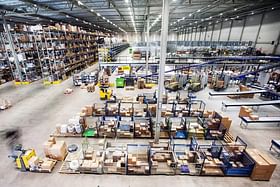This growth was mainly driven on better demand from third-party logistics players and manufacturing units.
The industrial and warehousing sector in India experienced a 7 per cent increase in total absorption, reaching 22.4 million square feet in the first half of 2023.
This is compared to the 20.9 million sq/ft absorbed in the first half of 2022.
This growth was mainly driven on better demand from third-party logistics (3PL) players and manufacturing units.
According to research by Savills India, Tier I cities accounted for 75 per cent of this absorption, while Tier II and III cities contributed the remaining 25 per cent.
Additionally, the industrial and warehousing sector also saw a significant growth in new supply, with 27.4 million sq/ft added during the same period. This reflects a 36 per cent increase from the first half of 2022.
In recent years, there has been a notable surge in demand for Grade A warehousing and ready fitted-out factory space.
In the first half of 2023, Grade A space accounted for 53 per cent of the total absorption in the country, a significant increase from the 36 per cent recorded in the first half of 2022.
The Top Cities Experiencing The Surge
Mumbai has emerged as the top city among Tier I cities, accounting for 18 per cent of the total absorption in the country.
Delhi-NCR closely follows with 14 per cent, and Pune with 10 per cent. Bengaluru and Chennai both recorded an absorption rate of 9 per cent.
Savills India’s Managing Director, Industrial and Logistics, Srinivas N, predicts an absorption of over 40 million sq/ft in 2023.
The industrial and logistics sector is on a growth trajectory, driven by domestic demand and the expansion of distribution networks in Tier II and Tier III cities.
These cities are experiencing substantial growth as key centres for sourcing and consumption, which is making distribution easier.
The absorption in these cities has increased by 22 per cent year-on-year going from 4.1 million sq/ft in the first half of 2022 to 5 million sq/ft in the first half of 2023.
The Driving Sectors
Sectors such as 3PL, manufacturing, urban warehousing, and retail are expected to contribute significantly to the absorption.
Over the past few years, the 3PL sector has played a crucial role in driving demand. This sector continued to drive warehousing demand in the first half of 2023, accounting for 44 per cent of the total absorption.
This marks a notable increase from the previous year, where it accounted for 37 per cent in H1 2022.
The manufacturing sector followed closely at 22 per cent, while the retail sector accounted for 13 per cent and the FMCG/FMCD sector accounted for 6 per cent.
India has strategically established multiple industrial corridors, which include planned multi modal logistics parks (MMLPs), along with government and private industrial parks.
These initiatives aim to support and promote growth in the country. The government has identified over 4.5 lakh hectares of land across various states that could potentially be utilised for establishing industrial and logistics hubs.


